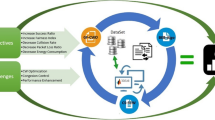Abstract
Fuzzy and hybrid genetic-fuzzy approaches were used to assess and improve quality of service (QoS) in simulated wireless networks. Three real-time audio and video applications were transmitted over the networks. The QoS provided by the networks for each application was quantitatively assessed using a fuzzy inference system (FIS). Two methods to improve the networks’ QoS were developed. One method was based on a FIS mechanism and the other used a hybrid genetic-fuzzy system. Both methods determined an optimised value for the minimum contention window (CW min) in IEEE 802.11 medium access control (MAC) protocol. CW min affects the time period a wireless station waits before it transmits a packet and thus its value influences QoS. The average QoS for the audio and video applications improved by 42.8% and 14.5% respectively by using the FIS method. The hybrid genetic-fuzzy system improved the average QoS for the audio and video applications by 35.7% and 16.5% respectively. The study indicated that the devised methods were effective in assessing and significantly improving QoS in wireless networks.
Similar content being viewed by others
References
Boyce J, Gaglianello R (1998) Packet loss effects on MPEG video sent over the public Internet. Proc ACM Multimedia 98: 181–190
Chen C, Hsiao P (2005) Supporting QoS in wireless MAC by fuzzy control. IEEE Wire Commun Netw Conf 2: 1242–1247
Chatzimisios P, Boucouvalas A, Vitsas V (2005) Performance analysis of the IEEE 802.11 MAC protocol for wireless LANs. Wiley Int J Commun Syst 18(6): 545–569
Dalgic I, Tobagi F (1996) Glitches as a measure of video quality degradation caused by packet loss. Technical Report No. CSL-TR-96–702, Computer Systems Laboratory, Department of Electrical Engineering and Computer Science, Stanford University, Stanford, USA
Gannoune L, Robert S (2004) Dynamic tuning of the contention window minimum (CWmin) for enhanced service differentiation in IEEE 802.11 wireless adhoc networks. IEEE Int Sympos Personal Indoor Mobile Radio Commun (PIMRC’04) 1: 311–317
Goldberg D (1989) Genetic algorithms in search, optimisation, and machine learning. Addison-Wesley
IEEE (1999) IEEE standard for wireless LAN medium access control (MAC) and physical layer (PHY) Specifications, ISO/IEC 8802-11:1999E
IEEE (2004) Wireless LAN medium access control (MAC) and physical layer (PHY) Specifications: Amendment 7: Medium Access Control (MAC) Quality of Service (QoS) Enhancement, IEEE Standard 802.11e/Draft 11.0
ITU-T (2001) Recommendation G.1010, End-user multimedia QoS categories
Liu Y, Hsu T (2005) MAC protocols for multi-channel WLANs. IEICE Trans Commun E88-B(1): 325–332
Mamdani E (1997) Application of fuzzy logic to approximate reasoning using linguistic systems. Fuzzy Sets Syst 26: 1182–1191
NS-2, Network simulator 2. [Online]. http://nsnam.isi.edu/nsnam/index.php/User_Information, last accessed 15 September 2008
Peng Y, Wu H, Cheng S, Long K (2002) A new self-adapt DCF algorithm. IEEE Globecom 87–91
Qixiang P, Soung L, Jack Y, Gary C (2004) A TCP- like adaptive contention window scheme for WLAN. IEEE Int Conf Commun 6: 3723–3727
Ross T (2004) Fuzzy logic with engineering applications. Wiley
Sakawa M (2002) Genetic algorithms and fuzzy multiobjective optimisation. Springer
Saraireh M, Saatchi R, Shur U, Strachan R (2004) Fuzzy logic based evaluation of quality of service for multimedia transmission. Proc PREP 2004: 13–14
Saraireh M, Saatchi R, Al-khayatt, S, Strachan, R (2006) Development and evaluation of a fuzzy inference engine to incorporate quality of service. In: Proceedings of IEEE international conference on wireless and mobile communications, Romania, pp 29–34
Saraireh M, Saatchi R, Al-khayatt, S, Strachan, R, Abo-Hammour, Z (2006) Optimisation of IEEE 802.11 MAC protocol parameters using a hybrid genetic-fuzzy approach. In: Proceedings of the IEEE systems, man and Cybernetics Society United Kingdom and Republic of Ireland conference on Advances in Cybernetics Systems, United Kingdom, Chapter 5, pp 253–258
Yener A, Rose C (1997) Genetic algorithms applied to cellular call admission: local policies. IEEE Trans Vehicular Technol 46(1): 72–79
Author information
Authors and Affiliations
Corresponding author
Rights and permissions
About this article
Cite this article
Saraireh, M., Saatchi, R., Al-khayatt, S. et al. Assessment and improvement of quality of service in wireless networks using fuzzy and hybrid genetic-fuzzy approaches. Artif Intell Rev 27, 95–111 (2007). https://doi.org/10.1007/s10462-008-9090-5
Published:
Issue Date:
DOI: https://doi.org/10.1007/s10462-008-9090-5




